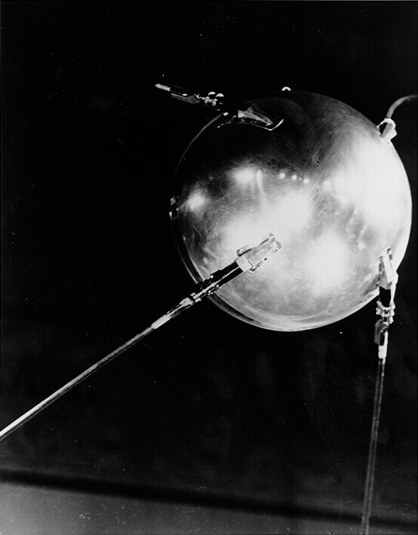 On October 4, 1947 the Soviet Union launched an artificial satellite called Sputnik, beginning a new age of technological and scientific innovation. When the United States was precluded into outer space, it pushed our government to approve funding for further advancements in launching our own satellite Explorer I. Explorer 1 was a scientifically significant satellite that upon its launch “discovered the magnetic radiation belts around the Earth” (NASA, 2007). Even more importantly, the launch of Sputnik was directly responsible for the creation of the National Aeronautics and Space Administration (NASA) as we focused on the competition between our nations and the new space frontier.
On October 4, 1947 the Soviet Union launched an artificial satellite called Sputnik, beginning a new age of technological and scientific innovation. When the United States was precluded into outer space, it pushed our government to approve funding for further advancements in launching our own satellite Explorer I. Explorer 1 was a scientifically significant satellite that upon its launch “discovered the magnetic radiation belts around the Earth” (NASA, 2007). Even more importantly, the launch of Sputnik was directly responsible for the creation of the National Aeronautics and Space Administration (NASA) as we focused on the competition between our nations and the new space frontier.
We are faced again with the battle into a new frontier; this time the scientifically technological world we all now live in right here on Earth. Arne Duncan, U.S. Secretary of Education, recently said “The country that out-educates us will out-compete us” (Koebler, 2011). This is already being done when we learn that “Many American companies have asked for an increase in the number of skilled foreign nationals they can bring into the country and have outsourced other jobs to countries such as India and China” (Koebler, 2011).
In order to be competitive, we need to do what other countries are doing by making sure our teachers are highly qualified in the subjects they teach and using the tools of our future, technology. When the United Kingdom had a teacher shortage they provided special stipends and signing bonuses in order to get teachers in the math and science fields. “The technological evolution has spread everywhere in America…everywhere except our schools” (Koebler, 2011). There is something wrong with that. How can we teach students to survive in a technological world if we don’t teach them using those technology tools?
In What’s our Sputnik?, Friedman shares that “China’s rise [is]…the 21st-century equivalent of Russia launching the Sputnik satellite – a challenge to which we responded with a huge national effort that revived our education, infrastructure and science and propelled us for 50 years” (2010). I agree with Friedman. When it comes to our innovative world, we are not leading the pact and it comes back to our need to educate and increase interest in science.
Resources:
Friedman, T. L. (2010, January 17). What’s our Sputnik? [Op-Ed]. The New York Times [Late Edition (East Coast)], p. WK.8.

